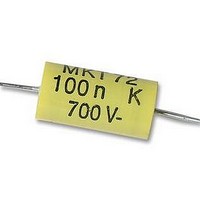26231941 Crouzet USA, 26231941 Datasheet - Page 141

26231941
Manufacturer Part Number
26231941
Description
CAPACITOR, MOTOR MEDIUM TORQUE CAPACITOR, MOTOR MEDIUM TORQUE
Manufacturer
Crouzet USA
Datasheet
1.26231909.pdf
(196 pages)
Specifications of 26231941
Capacitance
0.1UF
Voltage Rating, Dc
700V
Capacitor Dielectric Type
POLYPROPYLENE
Tolerance,
10%
Tolerance, -
10%
Temp, Op. Max
85(DEGREE C)
Temp, Op. Min
0(DEGREE
- Current page: 141 of 196
- Download datasheet (6Mb)
➜ Current per phase
This is the current rating per phase at zero frequency (motor stopped)
which produces the maximum permitted temperature rise for the motor in
operation. This current is measured when power & voltage are constant.
➜ Static holding torque
With the motor energised, the static holding torque is the torque which
must be applied via the motor shaft to induce continuous rotation.
➜ Holding torque (Cm)
The holding torque is the minimum torque which needs to be applied
to the rotor for it to turn, measurement being made with the «motor
energised two phases at a time» at zero frequency.
➜ Detent torque
This torque has the same definition as the holding torque but with the
motor de-energised.
➜ Elementary movement
There are 4 types of constraints which can influence a motor :
The inertial load JL
This factor only affects the motor during acceleration or deceleration,
and also influences the resonant frequency. If JL is the result of the load
inertia (directly applied to the motor shaft) the equivalent torque caused
by this inertia is a function of the transmission system (see later section
concerning mechanical aspects).
The antagonistic torque MR
This is the torque which opposes the general rotation of the motor.
A pulley and weight system best exemplifies this torque.
The resistive torque caused by viscous friction
This is proportional to the speed. By definition, this friction represents the
result of the actions of a liquid or a gas on a solid which moves though
liquid or gas. Cars and aircraft are good examples of this.
The resistive torque caused by dry friction
This is always against the direction of movement. By definition, this
friction represents the result of actions applied on a solid moving against
another solid.
Static characteristics
Dynamic characteristics
motor direction
a = step angle
Example of the paper feed on a printer.
Inertias:
J pinions + J gears + J rollers. These inertias must be applied to the
motor shaft.
Antagonistic torque:
This is the weight of the paper. It is not significant compared to the dry
friction torque.
Viscous friction torque:
This torque caused by the displacement of the roller in air is negligible.
Dry friction torque:
This is the torque caused by the friction of the different shafts (gears and
rollers) on their bearings.
Up to now, we have mentioned the external constraints but there are
constraints caused by inertia, viscous friction and dry friction inside the
motor.
Inertia:
Inertia of the rotor.
Viscous friction:
■
■
Dry friction:
For a given system, the variation of the antagonistic torque and the
frequency of the drive impulses determine the dynamic characteristics of
the motor.
➜ Dynamic torques
For a given system, the variation of the antagonistic torque and the
frequency of the drive impulses determine the dynamic characteristics of
the motor, for one power value.
Zone A
Operation possible but risk of excessive noise generation due to motor
shocks.
Zone B
Risk of loss of synchronisation : low frequency resonance.
Zone C
Stop-start zone.
Starting and stopping of the motor in this zone without loss of step.
Zone D
Overspeed zone.
Operation possible if the stopping and starting occur in zone C.
Zone E
Operation impossible.
Friction of the rotor in the air.
Resistive torque caused by resulting air flow of which the effect is the
equivalent of viscous torque.
Limit characteristic of
the stop-start condition
Limit characteristic of
the overspeed condition
141
5
Related parts for 26231941
Image
Part Number
Description
Manufacturer
Datasheet
Request
R

Part Number:
Description:
SCREW SOCKET (OT08PC)
Manufacturer:
Crouzet USA
Datasheet:

Part Number:
Description:
PANEL PLATE FOR 813
Manufacturer:
Crouzet USA
Datasheet:

Part Number:
Description:
Controller; CTD46 Dual Display Temperature, 1/16 DIN, NEMA 4X, 110/220VAC
Manufacturer:
Crouzet USA
Datasheet:

Part Number:
Description:
11R1084
Manufacturer:
Crouzet USA
Datasheet:

Part Number:
Description:
11R1086
Manufacturer:
Crouzet USA
Datasheet:

Part Number:
Description:
11R1087
Manufacturer:
Crouzet USA
Datasheet:

Part Number:
Description:
11R1089
Manufacturer:
Crouzet USA
Datasheet:

Part Number:
Description:
11R1078
Manufacturer:
Crouzet USA
Datasheet:

Part Number:
Description:
11R1079
Manufacturer:
Crouzet USA
Datasheet:










